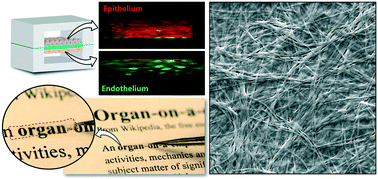Our official English website, www.x-mol.net, welcomes your
feedback! (Note: you will need to create a separate account there.)
Native extracellular matrix-derived semipermeable, optically transparent, and inexpensive membrane inserts for microfluidic cell culture
Lab on a Chip ( IF 6.1 ) Pub Date : 2017-08-15 00:00:00 , DOI: 10.1039/c7lc00317j Mark J. Mondrinos 1, 2, 3, 4 , Yoon-Suk Yi 1, 2, 3, 4 , Nan-Kun Wu 1, 2, 3, 4 , Xueting Ding 1, 2, 3, 4 , Dongeun Huh 1, 2, 3, 4
Lab on a Chip ( IF 6.1 ) Pub Date : 2017-08-15 00:00:00 , DOI: 10.1039/c7lc00317j Mark J. Mondrinos 1, 2, 3, 4 , Yoon-Suk Yi 1, 2, 3, 4 , Nan-Kun Wu 1, 2, 3, 4 , Xueting Ding 1, 2, 3, 4 , Dongeun Huh 1, 2, 3, 4
Affiliation

|
Semipermeable cell culture membranes are commonly used in multilayered microfluidic devices to mimic the basement membrane in vivo and to create compartmentalized microenvironments for physiological cell growth and differentiation. However, existing membranes are predominantly made up of synthetic polymers, providing limited capacity to replicate cellular interactions with native extracellular matrices that play a crucial role in the induction of physiological phenotypes. Here we describe a new type of cell culture membranes engineered from native extracellular matrix (ECM) materials that are thin, semipermeable, optically transparent, and amenable to integration into microfluidic cell culture devices. Facile and cost-effective fabrication of these membranes was achieved by controlled sequential steps of vitrification that transformed three-dimensional (3D) ECM hydrogels into structurally stable thin films. By modulating the composition of the ECM, our technique provided a means to tune key membrane properties such as optical transparency, stiffness, and porosity. For microfluidic cell culture, we constructed a multilayered microdevice consisting of two parallel chambers separated by a thin membrane insert derived from different types of ECM. This study showed that our ECM membranes supported attachment and growth of various types of cells (epithelial, endothelial, and mesenchymal cells) under perfusion culture conditions. Our data also revealed the promotive effects of the membranes on adhesion-associated intracellular signaling that mediates cell–ECM interactions. Moreover, we demonstrated the use of these membranes for constructing compartmentalized microfluidic cell culture systems to induce physiological tissue differentiation or to replicate interfaces between different tissue types. Our approach provides a robust platform to produce and engineer biologically active cell culture substrates that serve as promising alternatives to conventional synthetic membrane inserts. This strategy may contribute to the development of physiologically relevant in vitro cell culture models for a wide range of applications.
中文翻译:

天然的细胞外基质来源的半透性,光学透明和廉价的膜插入物,用于微流细胞培养
半透性细胞培养膜通常用于多层微流控设备中,以在体内模拟基底膜并创建分区的微环境,以促进生理细胞的生长和分化。然而,现有的膜主要由合成聚合物组成,提供了有限的能力来复制与天然细胞外基质的细胞相互作用,而天然细胞外基质在诱导生理表型中起关键作用。在这里,我们描述了一种新型的细胞培养膜,该膜是由天然的细胞外基质(ECM)材料制成的,该材料薄,半透,光学透明,并且易于整合到微流体细胞培养装置中。通过将玻璃化(3D)ECM水凝胶转变为结构稳定的薄膜的受控玻璃化连续步骤,可以轻松而经济地制造这些膜。通过调整ECM的组成,我们的技术提供了一种调节关键膜性能(如光学透明度,刚度和孔隙率)的方法。对于微流体细胞培养,我们构建了一个多层微设备,该设备由两个平行的小室组成,这些小室由衍生自不同类型ECM的薄膜插入物隔开。这项研究表明,我们的ECM膜在灌注培养条件下支持各种类型的细胞(上皮细胞,内皮细胞和间充质细胞)的附着和生长。我们的数据还揭示了膜对介导细胞与ECM相互作用的粘附相关的细胞内信号传导的促进作用。此外,我们证明了使用这些膜来构建分隔的微流体细胞培养系统,以诱导生理组织分化或复制不同组织类型之间的界面。我们的方法为生产和工程化具有生物活性的细胞培养底物提供了一个强大的平台,这些底物可作为常规合成膜插入物的有希望的替代品。这种策略可能有助于生理相关的发展体外细胞培养模型的广泛应用。
更新日期:2017-09-12
中文翻译:

天然的细胞外基质来源的半透性,光学透明和廉价的膜插入物,用于微流细胞培养
半透性细胞培养膜通常用于多层微流控设备中,以在体内模拟基底膜并创建分区的微环境,以促进生理细胞的生长和分化。然而,现有的膜主要由合成聚合物组成,提供了有限的能力来复制与天然细胞外基质的细胞相互作用,而天然细胞外基质在诱导生理表型中起关键作用。在这里,我们描述了一种新型的细胞培养膜,该膜是由天然的细胞外基质(ECM)材料制成的,该材料薄,半透,光学透明,并且易于整合到微流体细胞培养装置中。通过将玻璃化(3D)ECM水凝胶转变为结构稳定的薄膜的受控玻璃化连续步骤,可以轻松而经济地制造这些膜。通过调整ECM的组成,我们的技术提供了一种调节关键膜性能(如光学透明度,刚度和孔隙率)的方法。对于微流体细胞培养,我们构建了一个多层微设备,该设备由两个平行的小室组成,这些小室由衍生自不同类型ECM的薄膜插入物隔开。这项研究表明,我们的ECM膜在灌注培养条件下支持各种类型的细胞(上皮细胞,内皮细胞和间充质细胞)的附着和生长。我们的数据还揭示了膜对介导细胞与ECM相互作用的粘附相关的细胞内信号传导的促进作用。此外,我们证明了使用这些膜来构建分隔的微流体细胞培养系统,以诱导生理组织分化或复制不同组织类型之间的界面。我们的方法为生产和工程化具有生物活性的细胞培养底物提供了一个强大的平台,这些底物可作为常规合成膜插入物的有希望的替代品。这种策略可能有助于生理相关的发展体外细胞培养模型的广泛应用。











































 京公网安备 11010802027423号
京公网安备 11010802027423号